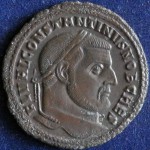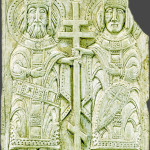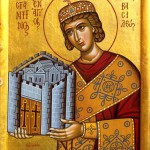Emperor Constantine the Great
In the month of February my collection was supplied with a follis of Constantine I the Great (306-337 CE). The coin is made out of bronze, its weight is 8,24 grams; the diameter – 28 millimeters. This coin was struck in Carthage in 306 CE.
On the obverse there is an image of the head of Emperor Constantine the Great wearing a laurel wreath, face right; the legend says, SALVIS AVGG ET CAESS FEL KART; left of the figure in the field there is a mint mark “Н”, in the exergue – “Г”. This particular coin has some numismatic value, because Emperor Constantine is depicted on it with a little beard, and the coin was struck in Carthage.
The personality of Emperor Constantine the Great is controversial. Some believe that Constantine was a saint; some believe that he was a bloody tyrant. So, who is Constantine the Great and what are his accomplishments?
CONSTANTINE I, CONSTANTINE THE GREAT (Flavius Valerius Aurelius Constantinus Augustus) (around 285–337 CE), is also called the first Roman Christian Emperor, who is better known as Saint Constantine the Great, Equal-to-the-Apostles. Constantine’s father (full name Flavius Valerius Constantinus) was Constantius Chlorus, his mother – Constantius’ consort (concubine) Helena (died circa 327, canonized). He was born in the city of Naissus (modern Niš, Serbia) in the province of Upper Moesia. By 293, when Constantius received the title of Caesar, he had been already married to Maximian’s stepdaughter. In his early years, Constantine served in the army under Diocletian in Nicomedia, participating in military campaigns against Persia and Egypt. When Diocletian and Maximian abdicated from authority in 305, Constantine’s father became the emperor in the West, where he called his son Constantine to come, who joined with his father’s expedition to Britain against the Picts. In 306, Constantius died in Eboracum (modern York), and the troops immediately declared Constantine the Augustus, but Galerius, against his own will, recognized him as only a Caesar (that is, a junior emperor).
The period of political instability began, when six contenders at the same time made their claims for power in the Roman Empire. In 307, Constantine, who secured his position in Gaul, married Fausta, a daughter of Maximian, one of his rivals, and the latter then recognized him as Augustus. But in 310, while Constantine was absent, Maximian tried to stage a coup, after which Constantine forced him to kill himself. When Galerius died in 311, there were only four Augusti left: Valerius Licinius and Maximinus Daza in the East, and Maxentius (Maximian’s son) and Constantine in the West. Constantine allied with Licinius, giving his sister Constantia in marriage to him, and marched toward Rome against Maxentius. In 312, on the eve of the Battle at the Milvian Bridge in the vicinities of Rome, Constantine, according to the legend, had a vision. According to church historian Eusebius, Constantine saw a fiery cross in the sky with an inscription in Greek below it saying, “With this sign you will conquer.” According to another version of Lactantius, Constantine had a dream, where he was instructed to put on the shields of his soldiers a Greek monogram signifying the name of Christ (letters X and P). One way or another, the next day Constantine won the victory, and Maxentius died together with his son; and as a sign of his victory, Constantine put the specified monogram on his labarum (the emperor’s standard).
In 313, Constantine together with Licinius announced the Edict of Milan, which allowed all Roman citizens to choose freely their faith. Christianity according to this edict became a “lawful” religion, and the property that had been confiscated from the church in the period of persecutions was returned. In the same year, Licinius defeated Maximin Daza, and for a decade the brothers-in-law – Licinius and Constantine, were ruling over the empire together: Constantine – in the West, and Licinius – in the East. But in 323 another conflict sparkled. The formal pretext was Constantine’s crossing the borders of the Eastern part of the Empire with his troops while fighting back the raids of the Goths and Sarmatians. Licinius declared a war. But Constantine also must have realized the need to finally resolve the question of authority. On top of that, starting from 321, Licinius restored the persecution of the Christians in his part of the Empire. In 324 Licinius was defeated in two battles – first at the Battle of Adrianople (today’s Edirne) on the European continent, and then at the Battle of Chrysopolis (modern Üsküdar) in Asia Minor, and removed from power, and later executed. Constantine became the sole ruler in the whole Roman Empire.
The rule of Constantine became the turning point in the history of Europe. Whatever the emperor’s motives were, Constantine favoured the growth of the Christian church. In 325, he called the Church Council of Nicaea (the First Ecumenical Council) to settle down the arguments concerning the Arian teaching and to formulate the Christian profession of faith, and he personally presided at many of its meetings. In 330, he founded Constantinople (modern Istanbul) in the place of the ancient Byzantium, and transferred his capital there. Later, Constantinople became the center of the Eastern Roman (Byzantine) Empire that existed until 1453. Constantine had many wonderful characteristics, but in 326 the execution of his son Crispus first, who was falsely accused by his stepmother Fausta, and then, when his son’s innocence became clear – the killing of Fausta, shows us his other side. Constantine died in Achyron, Nicomedia’s suburb, on 21 May, 337, during the preparations for the war with Persia; before his death he was baptized. Constantine divided the Roman Empire ahead of time between his sons: Constantine II (ruled in 337-340) received Britannia, Spain, and Gaul; Constantius II (ruled in 337-361) received Egypt and Asia; Constans (ruled in 337-350) received Africa, Italy, and Pannonia, and after his brother Constantine II’s death in 340, he got the whole of the West. Illyricum, Armenia, and Pont were given to Constantine’s two nephews – Dalmatius and Hannibalianus. One cannot say that such a division proved to be very wise: right after Constantine’s death, almost all of his relatives were killed by the army that desired to protect the throne from new contenders. The clashes between the heirs continued long after that, until 350, when only one emperor was left – Constantius II.
For his activity that promoted the spreading of Christianity, Constantine was canonized.
Literature: Kerensky V. A., Sources on Saint Constantine the Great. Kazan, 1913;
Brilliantov A. I., Emperor Constantine the Great and Edict of Milan of 313. Pg., 1916;
Kazhdan A. P., From Christ to Constantine. Moscow, 1965
Eusebius Pamphili, The Life of Saint Basileus Constantine. Moscow, 1998
This material is taken from Encyclopedia Krugosvet.






